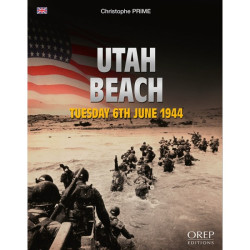





The battle on Omaha Beach is at the forefront of the collective memory for its tragic hours on 6 June 1944. The Utah Beach sector, located at the base of the Cotentin peninsula, has always been the subject of lesser attention. Wrongly so, for, according to General Eisenhower himself, the mission entrusted to Force U was the most complex one to be engaged on D-Day, due to the beach's distance from the other landing zones and the presence of several German divisions. Along with the 4th Infantry Division, the 82nd and 101st Airborne Divisions engaged in bitter combat in the sector. Its toll of losses, totalling some 3,500 men, illustrates how much Utah deserves further enlightenment.
Christophe PRIME
200 x 265 mm
128 pages

The battle on Omaha Beach is at the forefront of the collective memory for its tragic hours on 6 June 1944. The Utah Beach sector, located at the base of the Cotentin peninsula, has always been the subject of lesser attention. Wrongly so, for, according to General Eisenhower himself, the mission entrusted to Force U was the most complex one to be engaged on D-Day, due to the beach's distance from the other landing zones and the presence of several German divisions. Along with the 4th Infantry Division, the 82nd and 101st Airborne Divisions engaged in bitter combat in the sector. Its toll of losses, totalling some 3,500 men, illustrates how much Utah deserves further enlightenment.
Christophe PRIME
200 x 265 mm
128 pages
The historical artifacts for sale at PARATROOPER’s are intended for collectors, history enthusiasts, historians and museum curators.
These items do not glorify or promote any of the political, ideological or racial opinions related to the global conflicts that bathed the 20th century in blood.
Besides, we remind you that Article R.645-1 of the French Penal Code establishes fines applicable to fifth class contraventions (except in the specific cases of a filming, show or exhibition which refer to historical events) for any individual who wears a uniform, insignia or symbol reminiscent of those worn by members of the various organizations declared criminal in application of Article 9 of the Charter of the International Military Tribunal annexed to the London Agreement of August 8, 1945 – SS, SD, Gestapo, Nazi leaders (the Führer, the Reichsleitung, the Gauleiters and their main collaborators, the Ortsgruppenleiter, the Zellenleiter and the Blockleiter), or reminiscent of those worn by any person found guilty, by a French or International Jurisdiction, of one or several crimes against humanity established by Articles 211-1 to 212-3 or mentioned in Law No. 64-1326 of December 26, 1964.
The Code provides additional penalties, including the confiscation of the items used or intended for committing the offence.
